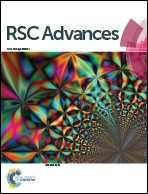Synthesis of polyhydroxyurethanes from di(trimethylolpropane) and their application to quaternary ammonium chloride-functionalized films†
Abstract
Polyhydroxyurethanes (PHUs) are synthesized by the polyaddition of di(trimethylolpropane) carbonate (DTMPC) and a series of conventional aliphatic diamines, and are then chemically modified through their side chains to design quaternary ammonium chloride (QAC)-functionalized PHU films. The reaction of DTMPC with a subtle excess of diamines affords PHUs with well-controlled molecular weights and polydispersities. The hydroxyl groups of these PHUs are modified with chloroacetyl chloride and then reacted with N,N-dimethyl-n-octylamine (DMOA) to easily give QAC-functionalized PHUs. On the other hand, the reaction of these PHUs with cross-linkable N,N,N′,N′-tetramethyl-1,6-diaminohexane (TMDAH) undergoes quaternization and simultaneously forms networked structures, resulting in the formation of QAC-functionalized PHU network films. In particular, the use of 20 mol% TMDAH, with respect to the chloroacetyl groups of the PHU unit, gives a self-supported film with a good transparency and higher thermal stability. Furthermore, the remaining chloroacetyl groups of the film can be modified with DMOA to afford PHU films with dual-structured QAC moieties. The resulting PHU film constructs positively charged surfaces with a zeta potential of +8.3 mV.


 Please wait while we load your content...
Please wait while we load your content...